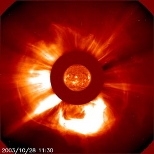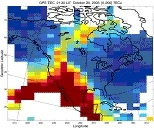On the morning of October 28, 2003 a gigantic solar flare sent a powerful burst of energy and matter racing out into space. It was the third most powerful ever measured and astronomers classified it as an X17.2 flare (on a scale of x-ray intensity ranging from 1 to 20). The coronal mass ejection associated with it unleashed a flood of charged particles directly toward Earth and triggered auroral displays seen as far south as Texas. During the next few days, two more giant eruptions of the Sun also sent their energy hurtling towards Earth.
During the next few days, two more giant eruptions also sent their energy hurtling towards Earth.
For the atmospheric scientists at MIT's Haystack Observatory who track dynamic interactions between the sun and Earth, these outbursts were the perfect storms: strong, fast-moving solar winds and streams of plasma interacting with Earth's magnetic field, creating magnetic disturbances and circulating electrical currents in the upper atmosphere. While satellite operators, pipeline companies and grid owners rushed to shut down and safeguard their equipment, Haystack space weather watchers swung into action, measuring the activity with the Westford, Mass.-based Millstone Hill Radar, a Global Positioning Satellite receiver tied into a worldwide network of more than 900 GPS sites and a series of optical instruments.
The observatory's radars, supported by the National Science Foundation, charted changes in the ionosphere (a region of the Earth's atmosphere extending from about 100 to 1,000 kilometers above the Earth's surface), measured the thickness of the ionosphere and tracked auroral displays as they danced overhead.
Now, more than two weeks after the events, the data gathered at Haystack and its associated facilities are just starting to be analyzed. Preliminary indications show incredible changes in Earth's upper atmosphere during late October, resulting from disturbances characterized by John Foster, the observatory's associate director and leader of the Atmospheric Sciences Group at Haystack, as the most violent in years. "These powerful storms were the biggest in this solar cycle and in this decade," he said. "The effects we've observed, such as the redistribution of the ionosphere, are the most pronounced of any we've seen to this date."
While the upper atmosphere is constantly changing during storms, Foster noted that the ionospheric redistribution during the latest events gave Haystack observers plenty of data to analyze over the coming months. "We are doing leading-edge research here at Haystack in this area," he said. "In particular, the mid-latitude geomagnetic storm response is something that we've been doing fundamental work on for the past couple of years."
Foster's team will use their data to quantify the size and effects of perturbations of the upper atmosphere, and integrate that into what's already known about space weather. And, since the sunspot group that birthed these outbursts will soon rotate Earthward, the science teams are getting ready for another round of severe space weather around Thanksgiving. "This group is large and active," Foster said. "It will come back and point at the Earth again, and when it does, we'll be ready for it. We're planning to have our full monitoring system in place to catch all the changes in Earth's ionosphere as they occur."
The sun and Earth: electrical ties that bind
These geomagnetic storms are powerful evidence of the electrical ties coupling Earth and the sun, particularly when they stir up activity in the near-Earth environment. Space weather-induced disturbances, plus the effects from more humdrum solar activity, have been a research focus of the Haystack group for more than 30 years. Yet it is only recently that the full story of sun-Earth interactions has started to unfold, and space weather plays a huge role.
The sun-Earth connection is an intricate one. Earth floats along cocooned inside a thick atmosphere, protected by a magnetic field (its magnetosphere), warmed by sunlight but also buffeted by the solar wind and stronger outbursts from the sun. The sun, in turn, has its own complex magnetic field structure. The most obvious manifestations of that structure show up as sunspots (where intense magnetic lines of force break through the surface), prominences (which are supported and pervaded by magnetic fields), and streamers and loops that are shaped by magnetic lines of force.
Outbursts from the sun are pervaded by magnetic fields, and when these hit Earth's magnetosphere, we get space weather. Solar ultraviolet radiation and X-rays interact with the top of our atmosphere to create the ionosphere, and radiation strips electrons of atoms of atmospheric gas, creating a region of positively charged ions and free negative electrons, usually pervaded by an electrical current. This ionospheric soup bends or reflects radio and radar signals and allows them to bounce around the planet. Changes in the composition, temperature and location of the ionosphere show up as perturbations in the propagation of radio signals, and those perturbations can be used as diagnostics of the ionosphere and the space weather that affects it.
Space weather originates with solar activity that arrives at Earth in stages, and during storms like those unleashed in late October, the magnetosphere really takes a beating. A snowstorm of energetic particles from an outburst starts to arrive about 20 minutes after the outburst and poses hazards to spacecraft electronics and any astronauts on orbit. Plasmas (with entrained magnetic fields) arrive a day or so after the flare. They set off geomagnetic storms, cause currents to flow in the magnetosphere, heat the ionosphere and energize particles, which in turn increases drag on orbiting satellites. The electrons in the ionosphere collide with molecules, causing auroral displays and raising the risk of electrostatic discharges that can damage spacecraft hardware.
During heavy bouts of space weather, material in the upper ionosphere is redistributed from Earth's lower latitudes to the mid-latitudes and ultimately up to the rarefied atmosphere over the polar regions. This happens very quickly, said Foster, who described charged plasmas in the ionosphere moving at speeds of a kilometer per second. "This material moves from the equatorial regions and South America up to the north slope of Alaska on about a 30-minute time scale," he said.
One effect that intrigues Foster's team is an apparent preferential perturbation in the ionosphere over the North American continent during geomagnetic storms. "This is an effect that is not well understood," he said. "It's an area where we're doing groundbreaking research to figure out why this sort of asymmetry exists."







